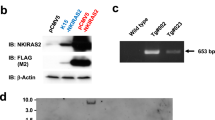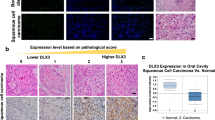Abstract
The CCAAT/enhancer binding protein β (C/EBPβ) is implicated in the regulation of many different molecular and physiological processes. Mice with a germline deletion of C/EBPβ (C/EBPβ−/−) display phenotypes in a multitude of cell types and organ systems, including skin where C/EBPβ−/− mice exhibit increased apoptosis in epidermal keratinocytes in response to carcinogen treatment and are completely resistant to carcinogen-induced skin tumorigenesis. To determine the contribution of systemic versus cell autonomous functions of C/EBPβ to specific phenotypes, mice with a conditional ‘floxed’ C/EBPβ null allele were generated. Epidermal-specific deletion of C/EBPβ was achieved by Cre recombinase expression from a keratin 5 (K5) promoter. Similar to C/EBPβ−/− mice, K5-Cre;C/EBPβfl/fl mice were completely refractory to 7,12 dimethylbenz[a]anthracene (DMBA)-induced skin tumorigenesis and these mice displayed increased DMBA-induced apoptosis in epidermal keratinocytes compared to wild-type mice. In contrast, mice lacking the related gene, C/EBPδ, were not resistant to DMBA-induced skin tumorigenesis, indicating a unique role of C/EBPβ in skin tumor development. Our findings demonstrate that C/EBPβ exerts an essential, keratinocyte-intrinsic role in cell survival in response to carcinogen treatment and the elimination of C/EBPβ in keratinocytes is sufficient to confer complete resistance of the skin to chemical carcinogenesis.
This is a preview of subscription content, access via your institution
Access options
Subscribe to this journal
Receive 50 print issues and online access
$259.00 per year
only $5.18 per issue
Buy this article
- Purchase on Springer Link
- Instant access to full article PDF
Prices may be subject to local taxes which are calculated during checkout




Similar content being viewed by others
References
Boutwell RK . (1983). Cancer Res 43: 2465s–2468s.
Bundy LM, Sealy L . (2003). Oncogene 22: 869–883.
de Bruin A, Wu L, Saavedra HI, Wilson P, Yang Y, Rosol TJ et al. (2003). Proc Natl Acad Sci USA 100: 6546–6551.
Huang AM, Montagna C, Sharan S, Ni Y, Ried T, Sterneck E . (2004). Oncogene 23: 1549–1557.
Johnson PF . (2005). J Cell Sci 118: 2545–2555.
Kim Y, Fischer SM . (1998). J Biol Chem 273: 27686–27694.
Klatt P, Serrano M . (2003). Carcinogenesis 24: 817–826.
Lamb J, Ramaswamy S, Ford HL, Contreras B, Martinez RV, Kittrell FS et al. (2003). Cell 114: 323–334.
Lewandoski M . (2001). Nat Rev Genet 2: 743–755.
Li W, Kessler P, Yeger H, Alami J, Reeve AE, Heathcott R et al. (2005). Cancer Res 65: 2592–2601.
Ma W, Tessarollo L, Hong SB, Baba M, Southon E, Back TC et al. (2003). Cancer Res 63: 5320–5328.
MacPherson D, Sage J, Crowley D, Trumpp A, Bronson RT, Jacks T . (2003). Mol Cell Biol 23: 1044–1053.
Oh H-S, Smart RC . (1998). J Invest Dermatol 110: 939–945.
Poli V . (1998). J Biol Chem 273: 29279–29282.
Porter KL, Chanda S, Wang HQ, Gaido KW, Smart RC, Robinette CL . (2002). Toxicol Sci 69: 42–48.
Ramirez A, Page A, Gandarillas A, Zanet J, Pibre S, Vidal M et al. (2004). Genesis 39: 52–57.
Ramji DP, Foka P . (2002). Biochem J 365: 561–575.
Rask K, Thorn M, Poten F, Kraaz W, Sundfeldt K, Hedin L et al. (2000). Int J Cancer 86: 337–343.
Robinson GW, Johnson PF, Hennighausen L, Sterneck E . (1998). Genes Dev 12: 1907–1916.
Screpanti I, Musiani P, Bellavia D, Cappelletti M, Aiello FB, Maroder M et al. (1996). J Exp Med 184: 1561–1566.
Screpanti I, Romani L, Musiani P, Modesti A, Fattori E, Lazzaro D et al. (1995). EMBO J 14: 1932–1941.
Shim M, Powers KL, Ewing SJ, Zhu S, Smart RC . (2005). Cancer Res 65: 861–867.
Shuman JD, Sebastian T, Kaldis P, Copeland TD, Zhu S, Smart RC et al. (2004). Mol Cell Biol 24: 7380–7391.
Sparmann A, Bar-Sagi D . (2005). Cancer Cell 6: 447–458.
Sterneck E, Tessarollo L, Johnson PF . (1997). Genes Dev 11: 2153–2162.
Sundfeldt K, Ivarsson K, Carlsson M, Enerback S, Janson PO, Brannstrom M et al. (1999). Br J Cancer 79: 1240–1248.
Tanaka T, Akira S, Yoshida K, Umemoto M, Yoneda Y, Shirafuji N et al. (1995). Cell 80: 353–361.
Tessarollo L . (2001). Methods Mol Biol 158: 47–63.
Wessells J, Yakar S, Johnson PF . (2004). Mol Cell Biol 24: 3238–3250.
Zhu S, Oh HS, Shim M, Sterneck E, Johnson PF, Smart RC . (1999). Mol Cell Biol 19: 7181–7190.
Zhu S, Yoon K, Sterneck E, Johnson PF, Smart RC . (2002). Proc Natl Acad Sci USA 99: 207–212.
Acknowledgements
We would like to thank Dr Peter Johnson for his scientific input; Barbara Shankle and Daniel Logsdon for expert technical assistance; Dr Lino Tessarollo for β-actin-cre mice and help with generating the C/EBPβfl/+ mice and Drs Mac Law and Phillip Sannes for their help with histological identification of pulmonary macrophages. This work was supported in part by National Cancer Institute Grant CA46637 (to RCS).
Author information
Authors and Affiliations
Corresponding author
Rights and permissions
About this article
Cite this article
Sterneck, E., Zhu, S., Ramirez, A. et al. Conditional ablation of C/EBPβ demonstrates its keratinocyte-specific requirement for cell survival and mouse skin tumorigenesis. Oncogene 25, 1272–1276 (2006). https://doi.org/10.1038/sj.onc.1209144
Received:
Revised:
Accepted:
Published:
Issue Date:
DOI: https://doi.org/10.1038/sj.onc.1209144
Keywords
This article is cited by
-
C/EBPβ expression decreases in cervical cancer and leads to tumorigenesis
BMC Cancer (2023)
-
Ablation of cDC2 development by triple mutations within the Zeb2 enhancer
Nature (2022)
-
Synthetic lethal kinases in Ras/p53 mutant squamous cell carcinoma
Oncogene (2022)
-
C/EBPβ deletion in oncogenic Ras skin tumors is a synthetic lethal event
Cell Death & Disease (2018)
-
The C/EBPβ LIP isoform rescues loss of C/EBPβ function in the mouse
Scientific Reports (2018)



